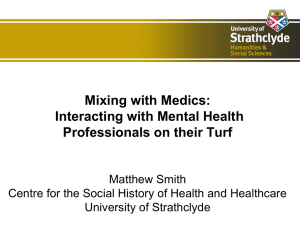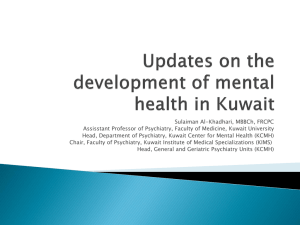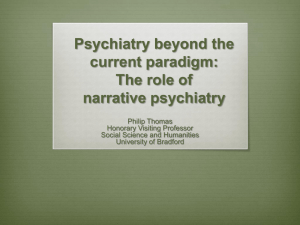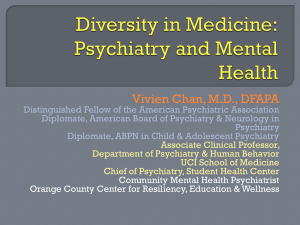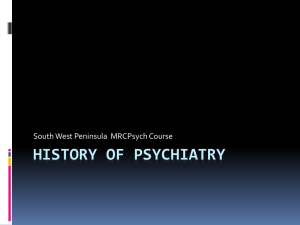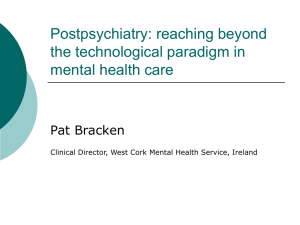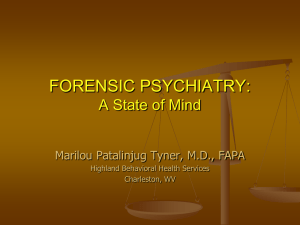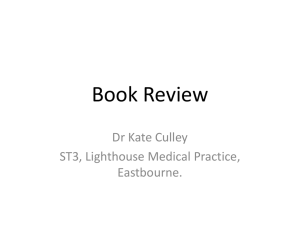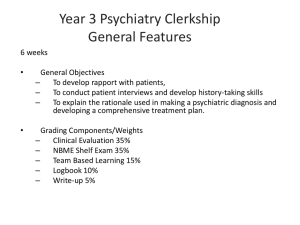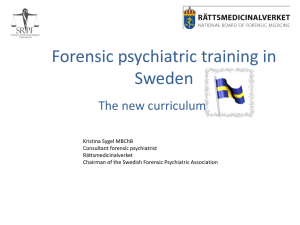here - Hearing the Voice
advertisement
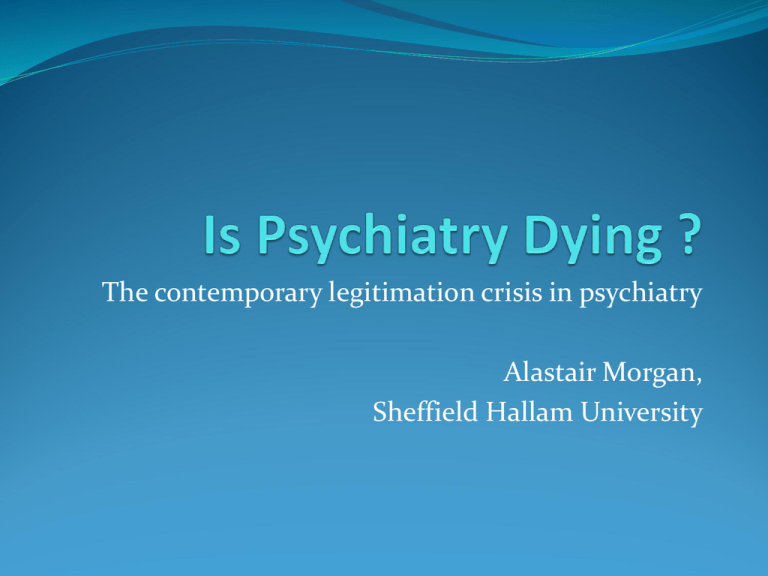
The contemporary legitimation crisis in psychiatry Alastair Morgan, Sheffield Hallam University Legitimation Crisis “…traditions can retain legitimising force only as long as they are not torn out of interpretive systems that guarantee continuity and identity”. Habermas, (1980:71). Habermas J (1980) Legitimation Crisis, translated by Thomas McCarthy, London: Heinemann Three areas for legitimation crisis - Cultural 1). Tradition A broad interpretive framework – a “way of seeing”. Different historical constructions of tradition. Pluralist cultural tradition – psychoanalysis, phenomenology, and psychiatry. Hybrid of understanding and explanation The handing over of tradition – a mutual process of critique and preservation – this has ossified in contemporary psychiatry 2). Paradigms – scientific questions of legitimation • Paradigms generate a set of problems, questions and horizons for scientific practice. • Kraepelinian tradition of classifying discrete mental illness syndromes ( often broad in nature) – Kraepelinian dichotomy • Neo-Kraepelinian restoration of that tradition – attempts to exclude pluralism - DSM-III. Klerman's neo-kraepelinian theses 1). Psychiatry is a branch of medicine. 2).Psychiatry should utilise modern scientific methodologies and base its practice on scientific methodologies. 3). Psychiatry treats people who are sick and who require treatment for mental illness 4). There is a boundary between the normal and the sick. 5). There are discrete mental illnesses. Mental illnesses are not myths. There is not one but many mental illnesses. It is the task of scientific psychiatry, as of other medical specialities, to investigate the causes, diagnosis and treatment of these mental illnesses. 6). The focus of psychiatric physicians should be particularly on the biological aspects of mental illness. 7). There should be an explicit and intentional concern with diagnosis and classification. 8). Diagnostic criteria should be codified and a legitimate and valued are of research should be to validate them. 9). Statistical techniques should be used to improve reliability. Klerman G (1978). ‘ The evolution of a scientific nosology’, in Shershow, J (ed). Schizophrenia: Science and Practice, Harvard: Harvard University Press. • Kraepelinian paradigm and neo- Kraepelinian restoration of the paradigm have both failed. • Lack of validity and reliability. • Proliferation of mental illnesses. • Inadequacy of treatment, and paucity of new treatments being developed. 3). The problem of authority – political questions of legitimation • What is the legitimation of authority for psychiatry ? • Expansion of coercive treatments, without an evidence base for their efficacy. • Problems in justifying its own professional position within medicine and beyond. Research Agenda for DSM-V (2002) –an acceptance of failure “not one laboratory marker has been found to be specific in identifying any of the DSM-defined syndromes”. “extremely high rates of comorbidities” “high degree of short-term diagnostic instability” “lack of treatment specificity is the rule rather than the exception” Kupfer D, First M, Regier D (eds) (2002) A research agenda for DSM-V, APA. A research agenda for DSM-V (2002) – awaiting the messiah “. . .reification of DSM-IV entities to the point that they are considered to be equivalent to diseases is more likely to obscure than to elucidate research findings”. A desire for an “ etiologically based, scientifically sound classification system” A demand for “fundamental changes in the neo-Kraepelinian paradigm. An “as yet unknown paradigm shift may need to occur” The hoped-for messiah – neuroscience (2003) A desire for a “brain-based nosology”. “mental disorders might arise from abnormalities in brain circuits” ( Hyman, 2003:98). “By combining neuroimaging with genetic studies, physicians may be able to move psychiatric diagnoses out of the realm of symptom checklists and into the domain of objective checklists” ( Hyman, 2003: 103). Hyman S (2003) ‘Diagnosing disorders’, Scientific American, September 2003: 97103. The failed messiah – neuroscience (2012) A faith in a new paradigm that would emerge from “genetics, neuroimaging, cognitive science and pathophysiology” ( Kupfer and Regier, 2011: 671) “We imagined that these emerging . . . advances. . .would impact faster than what has actually occurred” ( Kupfer and Regier, 2011: 672) Kupfer D and Regier D (2011) ‘Neuroscience, clinical evidence and the future of psychiatric classification in DSM-5’, Am J Psych, 168:7, July. What happened in these ten years Genetic complexity – no single genetic variant linked to mental illness. The complexity of social/environmental and polygenetic reactions. Lack of clear findings from neuroimaging studies. An increasingly dimensional approach to mental health and illness. An increasing awareness and grappling with brain plasticity This amounted to a complex challenge to biological reductionism. The split between DSM-5 and NIMH DSM-5 published as compromise document A “living document” Some introduction of dimensional diagnoses. Many radical proposals shelved - i.e. UHR traits for psychosis. NIMH – declares its split from DSM-5. Dr. Thomas Insel – current head of NIMH Insel’s blog post available at: http://www.nimh.nih.gov/about/director/2013 /transforming-diagnosis.shtml DSM “tweaks” current diagnostic categories. DSM not a “Bible”, but a dictionary. Lack of validity. Re-orienting research away from DSM-categories. A split in the US between research and clinical psychiatry. Is Psychiatry dying – the cultural question? Hugo Simberg – The Garden of Death -1896 A tending of the garden of the tradition Until something better arises The living document of DSM5 Is Psychiatry Dead – the scientific question? Conceptually dead It declared its lack of belief in its own categories. A lack of belief in validity A lack of belief in reliability A strong desire for redemption A repudiation from its appointed and longed for messiah Death in the sickroom – Edvard Munch - 1893 Is Psychiatry the living dead – the political question? Continues to diagnose more mental illness. Continues to prescribe more medication. Continues to coerce more people into treatment. The contemporary critical landscape Radical pluralism "Old psychiatry" The "suppressed potentials". Kraepelinian Cognitive or Behavioural Neuroscience Anti neokraepelinian The "failed messiah" Official psychiatry Anti-Kraepelinian. DSM -5. Conservative pluralism Neo-kraepelinian ??? The "practicing nonbelievers". The "penitents" Kraepelinian. Neo-kraepelinian Kraepelinians Worried about neoKraepelininans. Postsructuralist. Critical psychiatry "The new epoch" The "critical humanists" Anti -Kraepelinian Anti-Kraepelinian Neo-Kraepelinian ??? Anti neo-kraepelinain Official psychiatry – the “practicing non-believers” Still officially Kraepelinian and neo-Kraepelinian Disputes at the edges on the boundary between sickness and health ( 3 and 4 of neo-Kraepelinian paradigm). Bereavement, mild neurocognitive disorder, gender identity dysphoria, UHR traits for psychosis) A compulsive and frantic concern with diagnosis ( 7). Agnosticism/confusion about validation and reliability of the constructed diagnoses (8,9). Generally anti-pluralist tradition. Cognitive or behavioural neuroscience – the “failed messiah” Research Domain Criteria Dimensional system – looking at a range from normal to abnormal – thresholds not boundaries. Officially agnostic about current diagnostic categories, though highly sceptical Aims to generate new classifications from current knowledge of behaviour-brain relationships. A new pluralism ? Domains -negative valence systems, positive valence systems, cognitive systems, working memory, social processes, arousal and regulatory processes. Constructs within each domain – usually behavioural or cognitive in a limited way, that is amenable to testing in laboratory conditions or through fMRI. Units of analysis (genes, molecules, cells, circuits, physiology, behaviour, self-reports) A curious disavowal of reductionism, alongside a rigidly reductionist research agenda. A concept of human experience dependent on evolutionary theory, behaviourism and some core cognitive psychology. Limited reflexivity about their own paradigm. Anti- Kraepelinian Broadly anti neo-Kraepelinian – agree on points 6 and 7 Psychiatry should become clinical or applied neuroscience. Threshold between health and illness can be intervened upon prior to sickness. It is pointless trying to validate Kraepelinian constructs. The “new epoch” Modern subjects are entering a new dispensation. Increasing focus on the physical somatic basis for mental states. Focus on surface rather than depth. Somatic individuality Neurochemical selves Nikolas Rose Rose N and Abi-Rached J.M (2013) Neuro, Princeton: Princeton University Press. Against medicalisation thesis. This is another form of subjective formation, neither better nor worse. Service users as consumers demanding rights to better treatments. Demanding labels or keeping their labels – “Aspies”. “Better than well”. Anti- Kraepelinian, and anti neo-Kraepelinian. Psychiatry and medicine escape their bounds – more concerned with health than illness alone. Reflexive about current paradigm – anti-realist. Anti or post –humanist. Conservative pluralists – “the penitents” Attr. Guido Reni (1575 -1642)– the penitent Mary Magdalene Robert Spitzer – critique of lack of openness of DSM-5 process Allen Frances – Saving Normal. Nancy Andreasen – The death of phenomenology Tom Burns – Our Necessary Shadow Frances A (2013) Saving Normal, New York: William . Morrow “Normal badly needs saving; sick people desperately require treatment” ( Frances, 2013: xv). “Understanding the whole patient was often reduced to filling out a checklist” ( Frances, 2013: 67). “The past thirty years have witnessed a frightening vicious cycle. Diagnostic inflation has led to an explosive growth in the use of psychotropic drugs. .” (Frances, 2013: 77). Burns T (2013) Our Necessary Shadow. the Nature and Meaning of Psychiatry, London: Allen Lane. “Psychiatry is a hybrid – at least two distinct cultures ( understanding and explaining) and draws from a range of theories ( psychological, biological and the social)”. ( Burns, 2013: xlviii). “. . .the potential of the wellbeing movement to swamp psychiatry may be the profession’s intellectual salvation . . . A much needed review and retrenchment” ( Burns, 2013: 283) Conservative pluralists – “The penitents” A retrenchment for psychiatry. Treat the sick – leave the healthy alone. Careful diagnosis – a return to the skills of descriptive psychopathology ( away from the checklist). Kraepelinian constructs may be constructs but they are useful. Worries over diagnostic inflation – unintended consequences Pluralist in a piecemeal way ( don’t just dismiss psychoanalysis or phenomenology). Kraepelinian Broadly neo-Kraepelinian – division of sickness and illness, but worried about over emphasis on reliability at expense of understanding. A belief in pluralist roots of psychiatry – understanding and explanation. “Radical humanists” – Critical psychiatry Emphasis on alliance with service users –co-production of services, treatment and diagnoses. Concepts of recovery Emphasis on meaning, relations and context. Critique of the biomedical tradition in psychiatry. Anti-Kraepelinian – calls to end diagnosis Anti- neo-Kraepelinian – anti-positivist, although claims for EBP. Rational anti-psychiatry A range of different theoretical positions – broadly pluralist. A “complaint oriented approach” instead of diagnosis – Richard Bentall Take the experiences that people present with and respond appropriately. Start with the person in their social context and their self-understanding and then layers of descriptions. A human rights critique of coercive practices. Radical pluralism – old psychiatry – the “suppressed potentials” A return to that which has been passed over and forgotten. An interest in Kraepelinian and pre-Kraepelinian categories Anti neo-Kraepelinian Broad constructs can be useful and are much better than splitting. A different perspective on the sickness and health debate – mental health is an illusion. Anti-medicalisation An emphasis on psychic structures not surface phenomena Continental phenomenology ( EASE, Sass, phenomenology and neuroscience work) and psychoanalysis ( Leader). Darian Leader Leader D(2011) What is madness ? London: Penguin Leader D (2013)Strictly bipolar,London: Penguin. An interest in what can’t be fitted into a narrative. A rejection of surface symptomology An embrace of diagnostic failure and even failures of understanding. A challenge to the service user – “psychoanalysis involves not responding to the patient’s demands” A critique of medicalisation A critique of cognitive and behavioural models of experience. An understanding of madness as a construction - a mode of understanding the world. What is to be done ? Kraepelinian psychiatry It is dying as a paradigm. The idea that there are discrete mental illnesses with clear boundaries. The idea that there is a clear boundary between sickness and health. The idea that we should endeavour to validate these categories. Pluralists ( both conservative and radical) defend this to some degree, but a futile gesture. A possibility for a critical rescue of aspects of this tradition. Sickness and health A dignity in the response to distress. Is it possible for a psychiatric retrenchment ? The impossibility of mental health. Alongside the ethical demand to respond to suffering. A notion of continuity and discontinuity when thinking of sickness and health. A renewal of pluralism The interpretive tradition that is psychiatry is not solely dependent on Kraepelinian approaches. We still need conscious and explicit conceptualisations of mental distress. A defence of psychiatry as a “hybrid tradition” Its very “hybrid” status could make it a harbinger of a new kind of medicine. A different way of conceptualising understanding and explanation in contact with less reductive concepts in neuroscience and genetics. Aspects of a renewed pluralism- an emphasis on meaning A critical humanist agenda. Narratives of those with lived experience of mental distress. An attention to madness – to what cannot be formed as a story or easily understood. A rich attempt at a deep phenomenological understanding that is able to tolerate an inability to completely understand. A descriptive psychopathology that is severed from its Kraepelinian foothold. An emphasis on social and material context that is not reducible to “stress”. Against cognitivism and positivism Both DSM-5 and the NIMH RDoC are explicitly uninterested in any understanding of the meaning of mental distress. A desperate attempt to be rid of any phenomenology, including descriptive phenomenology. A reduced conception of experience – reduced to cognitions that can be replicated in functional tests. Behaviours that can similarly be tested A concept of society that is reducible to stress, threat, reward modalities. A concept of subjectivity that is dependent on reductive evolutionary notions of subjective agency. Neuroscience may consider itself pluralist. It only includes what can be measured. The NIMH are building up a vision of wellness and distress that is constructed on a reduced notion of experience. Only that which is quantified and quantifiable counts (positivism) A splitting of the psyche into disconnected functions Humanism – debating conceptions of experience In different ways all parties to the critical landscape apart from DSM-5 and the NIMH are interested in a project of human understanding. The possibility of conceptualisations of mental distress that begin with the human in a social context, and add layers of description to this, including layers of description from neuroscience and genetics Not a fixed notion of what it means to be human Judith Butler – “Becoming Human” – Butler J (2005) Giving an Account of Oneself, New York: Fordham University Press. Embodied exposure to the world – core vulnerability and openness ( can’t just be reduced to animal models of reward, threat and arousal – can’t be reduced just to the brain) Primary relations of childhood attachment, that can’t be fully recovered or narrated ( the unconscious) A narrative history of a life, with its own process of remembering and forgetting – a primary “opacity to myself”. The societal structures within which I am constituted as a subject but never completely constituted ( “something is missing”) A structure of intersubjective relations within which I tell my story, and within which I am allowed to tell my story.
